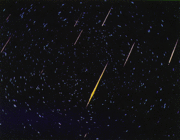Leonids
|
|
The Leonids are a prolific meteor shower associated with the comet Tempel-Tuttle. The meteor shower is visible every year around November 17 when the Earth moves through the Leonid meteor stream. The stream comprises solid particles, known as meteoroids, ejected by the comet as it passes by the Sun. The Leonids get their name from the location of their radiant in the constellation Leo: the meteors appear to stream from that point in the sky.
The Leonids are famous because their meteor showers, or storms, can be among the most spectacular. They tend to follow a 33 year cycle, associated with the 33 year orbit of Tempel-Tuttle. Storms in peak years can feature thousands of meteors per hour; notable events were observed in 1698, 1799, 1832, 1833, 1866, 1966, 1999, 2001 and 2002.
External links
- Leonid History (http://comets.amsmeteors.org/meteors/showers/leonids.html) by Gary W. Kronk (http://comets.amsmeteors.org/text_images.html)
- NASA: Background facts on meteors and meteor showers (http://leonid.arc.nasa.gov/meteor.html)
- NASA: Estimate the best viewing times for your part of the world (http://leonid.arc.nasa.gov/estimator.html)de:Leoniden
es:Leónidas fr:Léonides it:Leonidi ko:사자자리 유성우 he:לאונידים nl:Leoniden ja:しし座流星群 pl:Leonidy pt:Leónidas (chuva de estrelas) uk:Леоніди ru:Леониды

